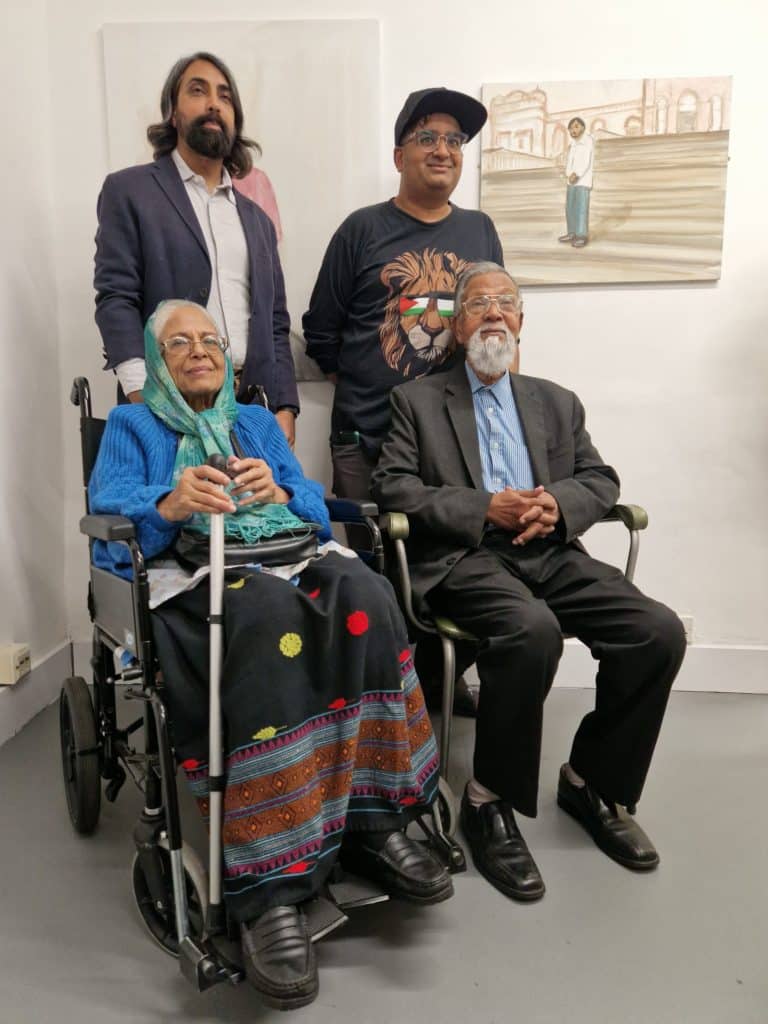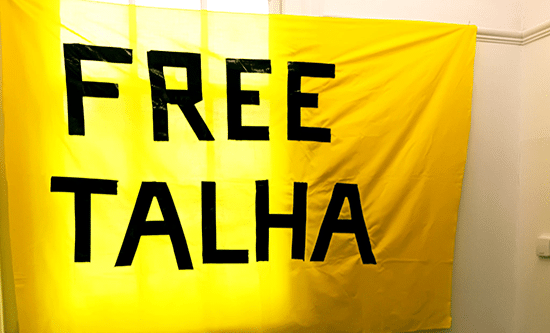My Brother is Back exhibition curated by Hamja Ahsan, Space Studios, Dormay Street, London, SW18 1EY, 21 August-8 September 2024,
An evil-looking clay sculpture of former Home Secretary and Prime Minister Theresa May; two issues of Fight Racism! Fight Imperialism! from 2012, featuring an article entitled ‘Extradition to Isolation’; a blue plaque bearing the words ‘Syed Talha Ahsan, poet and campaigner, was extradited from here 2012’; an archive of submissions to the European Court of Human Rights (ECtHR) and letters to a Connecticut judge; badges, posters, banners, books. These and other items make up the exhibition which artist and curator Hamja Ahsan has put together to mark the tenth anniversary of his brother’s return to England on 21 August 2014.

Talha Ahsan was arrested in July 2006 at his family home in Tooting, south London, on a warrant for extradition to the US to face flimsy, terrorism-related charges. Talha had never set foot in the US, but was alleged to have had some tangential relationship to websites partially hosted there. He spent six years in British high security prisons before being extradited to the US in October 2012, following the failure of a legal challenge in the ECtHR. Having spent over seven years in custody, in December 2013 he entered a plea bargain with the Connecticut court which resulted in his eventual release a further eight months later.
In response to his brother’s incarceration, Hamja Ahsan spearheaded a determined campaign to publicise Talha’s situation and that of other prisoners facing a similar fate. Using visual art, poetry, creative writing, comedy and food, alongside more traditional methods of protest, a wide spectrum of support was attracted. Ten years on from Talha’s release from solitary confinement in Connecticut and return to London, this exhibition reflects the breadth and diversity of that campaign. Although comprising just two rooms of exhibits, there are a multitude of things to look at and take in, with each item having many links back to the fight waged by the Ahsan family and their supporters to bring Talha home.
FRFI spoke to Hamja Ahsan and asked him first how campaigning for Talha made him become aware of more widespread injustice.
HA: If you look at the prisons that Talha was in, you have a history and a future of repression. Julian Assange was in Belmarsh; Gerry Conlon of the Guildford Four and members of the Birmingham Six were in Long Lartin. As a child I was always aware of the situation of Irish people in the 1970s and 1980s, and obviously my brother’s lawyer Gareth Peirce had represented a whole range of people facing injustice. Talha would often have deep conversations with her and her team and that would come back to me on family visits – everything from the miners’ strike to Hillsborough.
In challenging solitary confinement we learned about the earlier US war against the Black Panthers using COINTELPRO. I often just felt lonely so I would spend time listening to podcasts and watching videos about political prisoners. Robert King of the Angola 3 and I spoke together on platforms and he spoke up for Talha at a meeting of Amnesty International. When you have the history of solitary confinement and who it is used against, that makes you aware of a whole history of repression of people interested in anti-imperialist liberation.
FRFI: There was a strong element of racism in Talha’s case. Can you explain about that?
When Talha went to prison it was predominantly black and brown men there, disproportionately, and you saw that a lot of prison problems were rooted in social issues and the dismantling of welfare provision.
The white extradition suspects at the time were not imprisoned at all, even though some of the events were incredibly serious, such as hacking into US government computers or alleged arms dealing.
Talha had a job interview to be a librarian and was looking for a quiet academic career. He is a British citizen, born and raised. English is his first language and he’s only ever visited Bangladesh for 12 days as a teenager. But his British citizenship was not treated equally. The Daily Mail, being the most obvious, had a campaign called ‘British justice for British citizens’ for the white extradition cases, while referring to Talha and his co-defendant Babar Ahmed as ‘other unwanted guests’, even though they were equally British citizens under the law.
How are these elements reflected in the exhibition?
The exhibition has a whole section on sister campaigns. We have a zine called ‘British values’ made by Kieran Yates, with Theresa May on the front. It also looks at things like deportation. We have posters about indefinite detention at migrant centres.
When we went to the Home Office for vigils and demonstrations we saw that Theresa May did some really cruel things to migrants and people outside the border. I spent a lot of time reading the journal Race and Class, which was a brilliant education. I have also got Suhaiymah Manzoor-Khan (known as the ‘brown hijabi’) and her full reflections on the Prevent programme and domestic anti-Muslim racism. She also talks about Franz Fanon and the way policing in Britain is connected to imperialism. Upstairs in the exhibition I have more books about the oppression of Irish people, which is the prototype for a lot of oppression in Britain and the empire.
The exhibition is named after a short story by Uschi Gatward, which won an award. In it she imagines Talha’s journey back to his family. The story was compiled from a series of conversations and it’s a form of radical empathy which we need more of.
How is art useful as a tool in political campaigning?
We used art and poetry in the defence campaign. A lot of writers wrote to Talha, A L Kennedy being the most dedicated, but also Jeanne Theoharis, Mike Marqusee. They exchanged poetry, short stories. When you are in solitary confinement, you are stuck in a concrete box. There’s no education, stimulation. For your imagination to wander beyond that concrete box which is designed for sensory deprivation is a form of resistance.
In reaching the wider public, art can make the conversation start in a different place. Rather than news headlines or broadcast media, which have conventions about ‘balance’, so the BBC invites some extreme reactionary to provide ‘balance’. Plus the languages of mainstream media are too reductive to sum up the life experiences of, say, Muslims from the 1990s, which may not be readily understood.
Art can be a way of redistributing content outside the existing circuit. It can be a way to slow down, humanise. When you are in front of a TV camera, you have to sum everything up in a soundbite and that can often not be enough to show the full reality and impact of state oppression. Art can open up different time zones, languages, sensibilities, connections.
My Brother is Back is open every day 10am-9pm until 8 September. To make an appointment email [email protected] quoting #wipbrother and giving the time and date you want to visit the exhibition.
The articles from FRFI featured in the exhibition can be found here:




